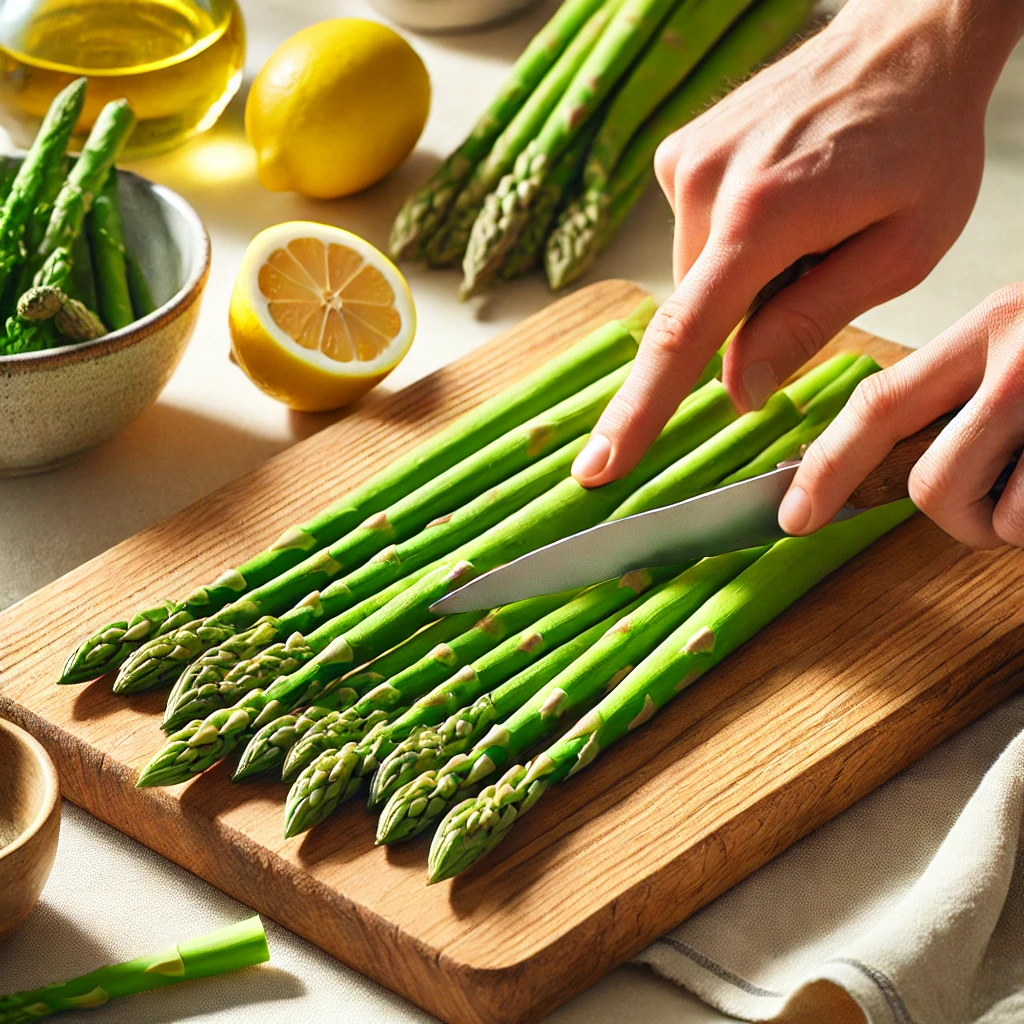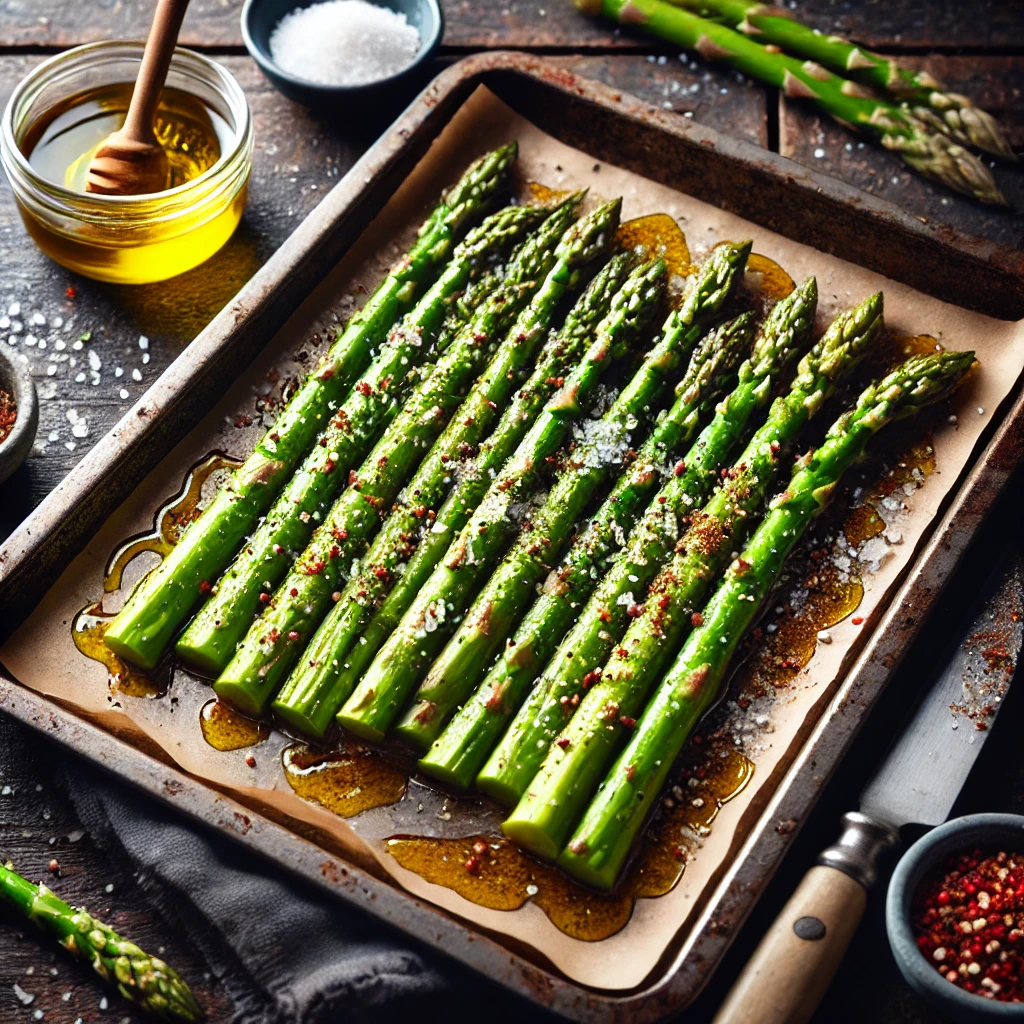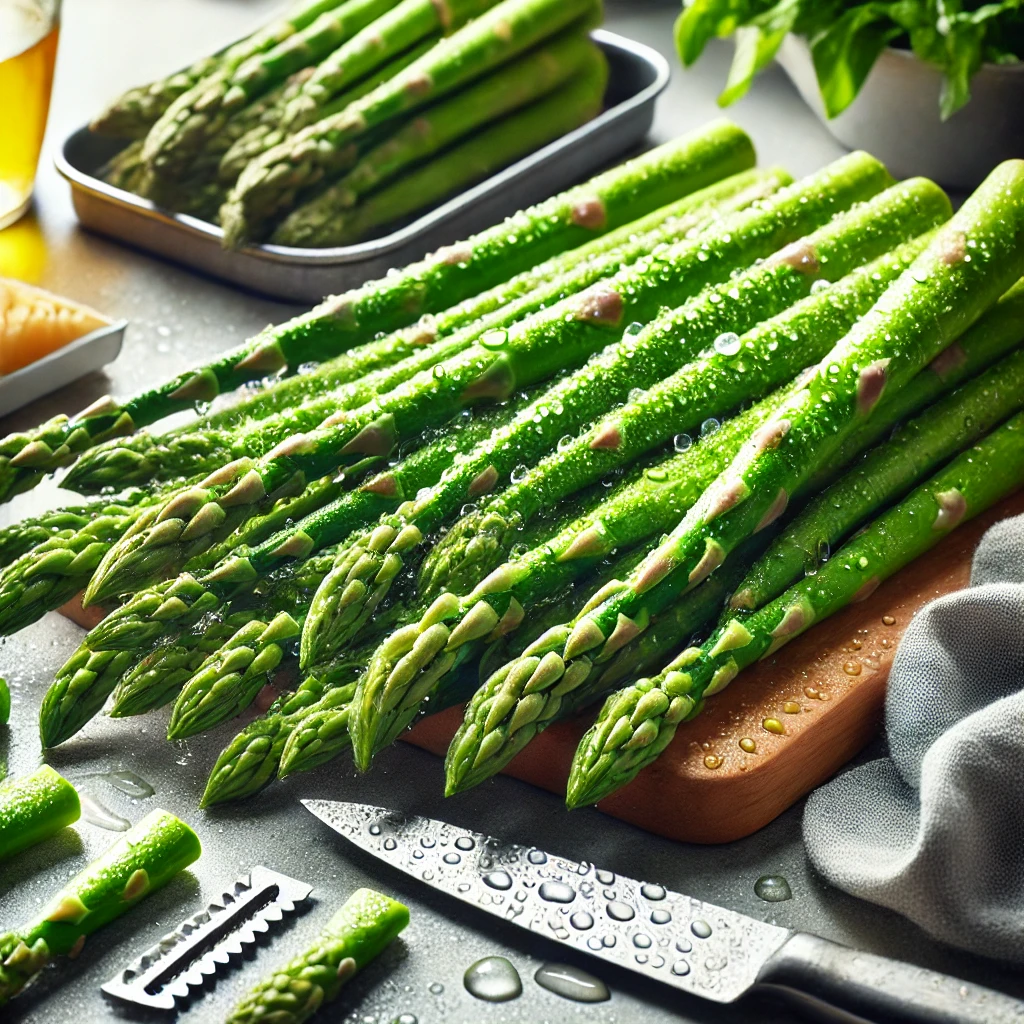Table of Contents
ToggleStep 1: Selecting Fresh Asparagus
The preparation process begins with choosing the right asparagus. Fresh asparagus not only tastes better but is also easier to prepare.
What to Look For:
- Firm stalks: The spears should feel firm and not limp.
- Closed tips: The tips should be tightly closed and free of slime.
- Vivid green color: Look for bright green spears with little to no yellowing.
- Uniform thickness: Choose spears of similar thickness for even cooking.
Pro Tip:
If you’re cooking immediately, thicker spears are great for grilling or roasting, while thinner ones are perfect for steaming or stir-frying.
Step 2: Washing the Asparagus
Asparagus grows in sandy soil, and its tips can trap dirt and grit. Cleaning it properly is a crucial step.
How to Wash:
- Rinse under cold water: Hold the stalks under running water, focusing on the tips to remove any trapped debris.
- Swirl in water: For especially dirty asparagus, submerge it in a bowl of cold water and swish gently to loosen grit.
- Dry thoroughly: Pat the spears dry with a clean towel or paper towel. This step is particularly important if you’re grilling or roasting.
Step 3: Trimming the Woody Ends
The bottom ends of asparagus are tough and fibrous, making them unpleasant to eat. Removing these parts ensures a tender, delicious spear.

Methods for Trimming:
- Snap Method:
- Hold the spear near the bottom and bend until it naturally snaps.
- The spear will break where the woody end meets the tender part.
- Repeat for each spear, or use one as a guide to trim the others.
- Knife Method:
- Line up the asparagus spears on a cutting board.
- Use a sharp knife to cut off 1-2 inches from the bottom, or wherever the color changes from green to white.
Step 4: Peeling (Optional)
Thicker asparagus spears sometimes have tough outer skins that can make them chewy. Peeling the lower part of the stalk is optional but can enhance texture, especially for grilling or roasting.
How to Peel:
- Use a vegetable peeler.
- Start just below the tip and peel downward, removing the outer layer of the lower stalk.
- Rotate the spear as you peel for even results.
Step 5: Seasoning and Prepping for Cooking

Once your asparagus is clean and trimmed, it’s time to prep it for your chosen cooking method. Here are the basics:
1. Season Simply:
- Toss the spears in olive oil, salt, and pepper for a basic seasoning.
- Add garlic, lemon zest, or red pepper flakes for extra flavor.
2. Marinate for Depth:
- Combine olive oil, minced garlic, lemon juice, and herbs in a bowl.
- Let the asparagus marinate for 10-15 minutes before cooking.
3. Skewer Thin Spears:
- If grilling thin spears, thread several onto a skewer to make flipping easier.
4. Cut for Recipes:
- Chop into bite-sized pieces for stir-fries or pasta dishes.
- Slice thinly with a mandoline for raw salads.
Common Prep Mistakes to Avoid
1. Skipping the Cleaning Step
- Dirt and grit in the tips can ruin the texture of your dish. Always rinse thoroughly.
2. Not Trimming Enough
- Leaving too much of the woody end results in tough bites. Don’t hesitate to trim generously.
3. Skipping the Drying Step
- Wet asparagus won’t caramelize properly when roasting or grilling. Ensure it’s completely dry before cooking.
4. Over-Seasoning
- Asparagus has a delicate flavor that can be overshadowed by too much seasoning. Keep it simple to let the natural taste shine.
How to Prep Asparagus for Specific Cooking Methods
1. Grilling
- Trim the ends and toss with olive oil, salt, and pepper.
- Optionally marinate for extra flavor.
- Skewer thin spears for ease of handling.
2. Roasting
- Preheat the oven to 400°F (200°C).
- Toss the spears in olive oil, salt, and pepper.
- Spread them out on a baking sheet in a single layer.
3. Steaming
- Trim the ends and leave the spears whole.
- Place in a steamer basket over boiling water.
- Steam for 3-5 minutes until tender-crisp.
4. Sautéing
- Trim and cut into 2-inch pieces.
- Heat olive oil or butter in a pan and cook over medium heat for 5-7 minutes.
5. Raw for Salads
- Trim and peel the spears.
- Slice thinly using a vegetable peeler or mandoline.
- Toss with lemon juice and olive oil for a fresh, crunchy addition to salads.
Final Thoughts
Prepping asparagus properly is the key to unlocking its full potential. Whether you’re grilling, roasting, or steaming, taking the time to clean, trim, and season your spears ensures they turn out tender, flavorful, and perfectly cooked. With these tips in hand, you’re ready to make asparagus a star in your next meal!
FAQs
1. How far in advance can I prep asparagus?
- You can wash and trim asparagus up to 2 days ahead. Store in the refrigerator wrapped in a damp paper towel.
2. Do I need to peel all asparagus?
- Peeling is optional and typically only necessary for thicker stalks.
3. Can I eat raw asparagus?
- Yes! Raw asparagus is delicious in salads when thinly sliced or shaved.
4. How do I store prepped asparagus?
- Place trimmed asparagus in a container with a small amount of water or wrap in a damp paper towel, then refrigerate.
5. What’s the best way to clean asparagus?
- Rinse under cold water or soak briefly in a bowl of water to remove grit.
6. Why are the ends of asparagus woody?
- The woody ends are the older, fibrous parts of the stalk that don’t soften when cooked.
7. What should I do if my asparagus is limp?
- Soak it in ice water for 10-15 minutes to restore firmness.
8. How do I know if asparagus is fresh?
- Fresh asparagus has firm stalks, closed tips, and a bright green color.
9. Can I use frozen asparagus?
- Yes, but thaw and pat it dry before cooking to avoid excess moisture.
10. What’s the best thickness for cooking asparagus?
- Medium-thick spears are the most versatile and work well for all cooking methods.

